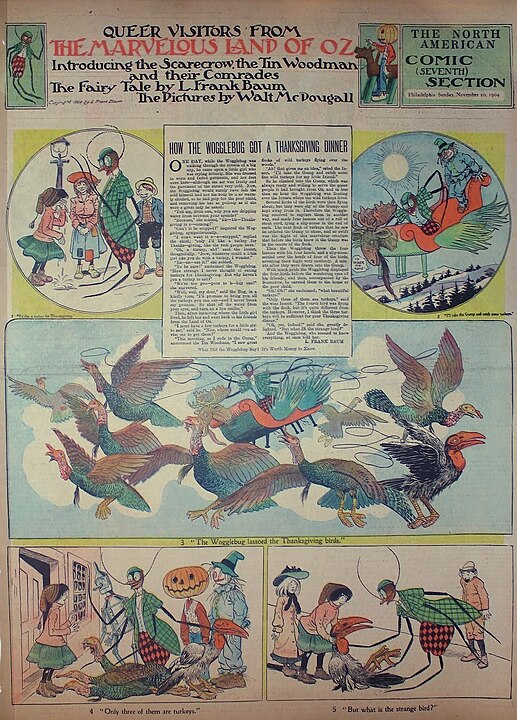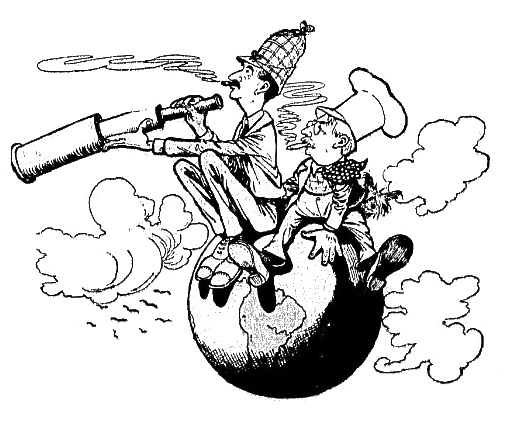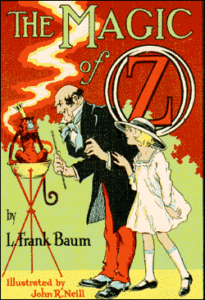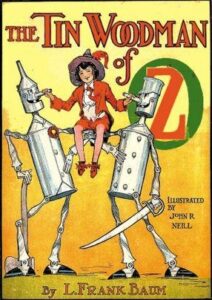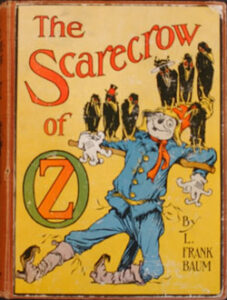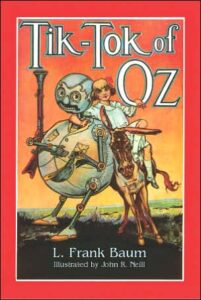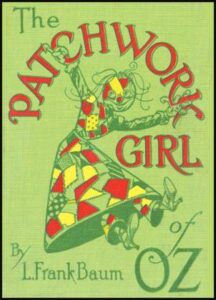
The Woggle-Bug Book is related to the Oz series of books.
Click here to download this book.
Read this book online and get more download options and a bibliographic record on Project Gutenberg by clicking here.
You can download the main fourteen fantasy books in the Oz series by L. Frank Baum via Project Gutenberg by clicking here.
About The Woggle-Bug Book
The Woggle-Bug Book has long been one of the rarest items in the Baum bibliography.
The book grew out of another promotional project, Queer Visitors from the Marvelous Land of Oz (1904 – 1905), a popular comic strip that promoted Baum’s second Oz book, The Marvelous Land of Oz (1904). The comic strip, written by Baum and illustrated by Walt McDougall, brought Oz characters including the Scarecrow, the Tin Woodman, and others to the United States for various humorous adventures. The Woggle-Bug Book employs the same concept. H. M. Woggle-Bug, T. E. is shown maladjusted to life in an unnamed American city. The book’s artist, Ike Morgan, was a Chicago cartoonist who had earlier provided illustrations for Baum’s American Fairy Tales (1901).
Baum’s Woggle-Bug was a popular character at the time. There were Woggle-Bug postcards and buttons, a Woggle-Bug song, and a Woggle-Bug board game from Parker Brothers. Baum and Morgan’s picture book was published in January 1905, to help publicize a new musical play, The Woggle-Bug, that was being mounted that year. The play flopped. The book was copiously illustrated, with pictures and text alternating on recto and verso pages; it was printed in bright colours in a large format, eleven by fifteen inches.
The Plot
SPOILER ALERT: Skip this bit if you haven’t read the book and are planning to do so!
The Woggle-Bug Book features the broad ethnic humour that was accepted and popular in its era, and which Baum employed in various works. The Woggle-Bug favours flashy clothes with bright colours. He dresses in gorgeous reds and yellows and blues and greens and carries a pink handkerchief. One day he falls in love with a gaudy Wagnerian plaid dress that he sees on a mannequin in a department store window. Being a woggle bug, he has trouble differentiating between the dress and its wearers, wax or human. The dress is on sale for $7.93 with GREATLY REDUCED written on the tag. The Bug works for two days as a ditch digger for money to buy the dress. He earns double pay since he digs with four hands.
He arrives too late, though and the dress has been sold and makes its way through the second-hand market. The Bug pursues his love through the town, ineptly courting the Irish, Swedish, and African-American women and even one Chinese man who had the dress in turn. His pursuit eventually leads to an accidental balloon flight to Africa. There, menacing Arabs want to kill the Woggle-Bug, but he convinces them that his death will bring bad luck. In the jungle, he falls in with the talking animals that are the hallmark of Baum’s imaginative world.
In the end, the Bug makes his way back to the city, with a necktie made from the dress’s loud fabric. He wisely reconciles himself to his fate. “After all, this necktie is my love” he said, “and my love is now mine forevermore! Why should I not be happy and content?”
There are plot exploit elements that occur in other Baum works such as an accidental balloon flight that took the Wizard to Oz in Baum’s most famous book and hostile Arabs are a feature of John Dough and the Cherub (1906).
Blog Posts
Books: The Oz Series By L. Frank Baum.
Books: The Wonderful Wizard Of Oz By L. Frank Baum.
Books: The Marvelous Land Of Oz By L. Frank Baum.
Books: Ozma Of Oz By L. Frank Baum.
Books: Dorothy And The Wizard In Oz By L. Frank Baum.
Books: The Road To Oz By L. Frank Baum.
Books: The Emerald City Of Oz By L. Frank Baum.
Books: The Patchwork Girl Of Oz By L. Frank Baum.
Books: Tik-Tok Of Oz By L. Frank Baum.
Books: The Scarecrow Of Oz By L. Frank Baum.
Books: Rinkitink In Oz By L. Frank Baum.
Books: The Lost Princess Of Oz By L. Frank Baum.
Books: The Tin Woodman Of Oz By L. Frank Baum.
Books: The Magic Of Oz By L. Frank Baum.
Books: Glinda Of Oz By L. Frank Baum.
Books: Queer Visitors From The Marvelous Land Of Oz By L. Frank Baum.
Notes And Links
The 1905 front cover image shown at the top of this page is copyright of Ike Morgan and is in the Public Domain via Wikipedia.
Project Gutenberg – Project Gutenberg is an online library of free e-books and was the first provider of free electronic books. Michael Hart, the founder of Project Gutenberg, invented e-books in 1971 and his memory continues to inspire the creation of them and related content today.
The Wonderful Wiki of Oz – Official website. A wonderful and welcoming encyclopedia of all things Oz that anyone can edit or contribute Oz-related information and Oz facts to enjoy.
The Oz Archive on Facebook – Archiving and celebrating the legacy of Oz.
The Oz Archive on Twitter – Archiving and celebrating the legacy of Oz.
The Oz Archive on Instagram – Archiving and celebrating the legacy of Oz.
The Oz Archive on TikTok – Archiving and celebrating the legacy of Oz.

